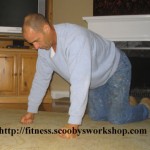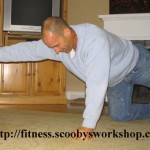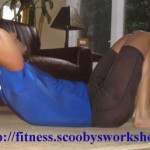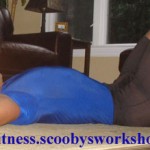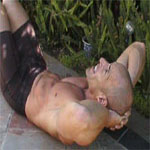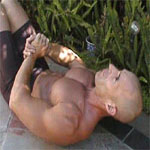Preventing Lower Back Pain
According to the CDC, back pain is the leading cause of disability in the U.S and results in $50 billion annually in health care and workers’ compensation costs. With exercise and proper strengthening of the back muscles and the abdominals, the muscles that support the back, the frequency of back pain can be decreased. In this country we often look for the quick fix and many get spine surgery before they have given physical therapy and adequate chance resulting in many unhappy patients. For instance, spine surgeons often quote a 98% success rate for fusion surgery. This percentage however refers to the success of the fusion process, not the reduction of pain. In fact, for workman’s comp patients, the success rate is only 29% (Surg Neurol 1998 Mar;49(3):263-7; discussion 267-8). Here is the point – do everything you can to protect your back because surgery rarely helps once you have screwed it up!
Lets talk about some of the research that has been done as it all conflicts and explore some of the possible reasons for the differences. Starting with the most disturbing study first, Hurwitz’ paper in the American Journal of Public Health showed that doing specific back exercises actually made lower back pain worse! I know exercise can help lower back pain so what this study tells me is how important it is to have a properly supervised exercise program and how important it is to very carefully choose your physical therapist. On a brighter note, a study done by Jill Hayden published in the 5/3/05 issue of the Annals of Internal Medicine shows that a supervised stretching (and exercise) program may reduce lower back pain. The best news of all comes from an 1984 study in Copenhagen done by Biering-Sorensen which shows that isometric endurance, not strength, strongly correlates with low back pain. The reason I find this good news is that it gives us a specific measurable goal (isometric endurance) in our exercise program which should help us prevent lower back pain. If you want to read abstracts of these lower back articles, and others as well, see my abstract section.
Below are some exercises and stretches you can do to keep your lower back strong, limber and well supported. The most important thing to work on is your isometric endurance in the hyperextension exercise as this has shown to help the most in reducing lower back pain. Remember though that even the strongest mid-section can’t shield your lower back from injury if you use bad form when lifting heavy objects at home or in the weight room. Posture can make a huge difference in preventing back strain too, make sure you posture is correct. If you have lower back pain already, you need to check with your doctor first before doing these exercises and stretches to make sure they will not aggravate your condition. If you pain is a simple muscle pull like I usually have, these stretches and exercises not only feel good but get you back to 100% fast. The morning after a tough day of beach volleyball my lower back can be so painful that it takes 30 minutes of doing these before I walk or sit without pain.
I have a herniated disk which is pinching a nerve and have been able to keep the pain manageable using these techniques. At some point I will probably need to try a transforaminal epidural cortisone injection but I want to make sure I have exhausted all other means first.
“Superman’s” – Prone Back Extensions
Strengthening these lower back muscles is critical to protecting your lower back from injury and isometric endurance is the goal. Think about it, your back needs support 16hrs a day, endurance is much more important than brute strength. If you have recently pulled a muscle in your lower back, this will be very difficult and you might have to skip this and just do the ‘opposite arm and leg raise’ exercise. If your back is doing fine, you can use the hyperextension machine at the gym with added light weights to further strengthen the lower back. This is the most important exercise you can do for your lower back! If you cant hold this position for at least 58 seconds, you are in the group most likely to experience agonizing lower back pain in the next year according to the Biering-Sorensen study!
Hamstring Stretch
Opposite arm and leg raise exercise
If you have recently pulled a muscle in your lower back, this will be very difficult. Go slowly and do the best you can. Your abs are flexed tight during this whole exercise to support your lower back. Concentrate on keeping your entire torso perfectly stationary and flat during this exercise, only your limbs move.
Starting Position: Hands shoulder width apart on a soft padded surface, hips and knees at 90 degrees. Abs are flexed tight, butt is flexed tight and the pelvis is rotated (suck your gut in).
Raise left arm and right leg off floor level with the back while stabilizing with the back and abdominal muscles. Keep your hips and shoulders horizontal, dont let either unsupported hip or shoulder drop. Back to starting position
Ending Position: Raise right arm and left leg off floor level with the back while stabilizing with the back and abdominal muscles. Keep your hips and shoulders horizontal, dont let either unsupported hip or shoulder drop. Repeat 10-15 times.
Rotisserie Core Workout
If you can do supermans pain free and are ready to move to the next level, side planks and front planks are a good next step. The rotisserie core workout is a great way to combine all the planks into one core workout that can help you regain the core strength you need to avoid further injuries.
Floor Crunches
Starting position: Inhale, try and get your belly button as close to the floor as you can.
Ending position: It helps to stare at a spot on the ceiling and try and make your head move directly to that spot. No bending the neck, no flapping the arms – the upper body is slowly levitated toward the ceiling.
Key points on form: You are lifting your shoulders up toward the ceiling, it helps to look at a spot on the ceiling and try and make your shoulders go there. No motion at all with the head, the head-nods that many people mistakenly do wont help your abs. Keep the feet flat on the ground and the knees bent.
Floor Side Crunch
Starting Position: You body is twisted, knees bent at 90 degrees, hand lightly behind the neck. Inhale.
Ending Position: While looking at the ceiling, raise your left shoulder in a straight line toward the ceiling – again think about your shoulder moving in a straight line up to the ceiling. Your neck, head, arms and legs do not move. Exhale on the way up.
Don’t feel bad if you have trouble with this one at first, its pretty difficult at first. Its easier if you start with the cable crunch (see below) to get the feel for which muscles you are using.
I personally do these exercises three times a week and the stretches daily but I have very good motivation as I have chronic back pain. I can go two or three months without pain but I keep up the stretching and exercises. My problem is muscular so I can safely continue all these exercises and stretches when my pain flares up, in fact, I do them seven days a week when I’m having pain. My worst episode was after four days straight of doing roofing work from a cramped seated position. While sleeping after day four, I yawned and stretched out during the night and heard a ‘pop’ during the stretch. Thinking nothing of it, I got up to go to the bathroom had the most intense bolt of pain in my back I have ever felt which left me collapsed on the hallway floor. Only after taking 800mg of ibuprofen and 60 minutes of laying on the floor was my partner able to get me back into my bed. Since I have started doing these exercises regularly, I have had no repeat of this kind of pain – thank god. Now when I get it, its just a dull constant pain that goes away with 15 minutes of stretching and exercises. I really think this routine has saved me from having back surgery.
Lower Back Pain Research Abstracts
“The effect of low back pain on the size of the lumbar multifidus muscle was examined using real-time ultrasound imaging. Bilateral scans were performed in 26 patients with acute unilateral low back pain (LBP) symptoms (aged 17-46 years) and 51 normal subjects (aged 19-32). In all patients, multifidus cross-sectional area (CSA) was measured from the 2nd to 5th lumbar vertebrae (L2-5) and in six patients, that of S1 was also measured. In all normal subjects, CSA was measured at L4 and in 10 subjects measurements were made from L2-5. Marked asymmetry of multifidus CSA was seen in patients with the smaller muscle being on the side ipsilateral to symptoms (between-side difference 31 +/- 8%), but this was confined to on vertebral level. Above and below this level of wasting, mean CSA differences were <6%. In normal subjects, the mean differences were <5% at all vertebral levels. The site of wasting in patients corresponded to the clinically determined level of symptoms in 24 of the 26 patients, but there was no correlation between the degree of asymmetry and severity of symptoms. Patients had rounder muscles than normal subjects (measured by a shape ratio index), perhaps indicating muscle spasm. Linear measurements of multifidus cross-section were highly correlated with CSA in normal muscles but less so in wasted muscles, so CSA measurements are more accurate than linear dimensions. The fact that reduced CSA, i.e. wasting, was unilateral and isolated to one level suggests that the mechanism of wasting was not generalized disuse atrophy or spinal reflex inhibition.”
Hides J.A., Stakes M.J., Saide M., Jull G.A., Cooper D.H., “Evidence of Lumbar Multifidus Muscle Wasting Ipsilateral to Symptoms in Patients with Acute/Subacute Low Back Pain,” Spine, Vol. 19, No. 2, January 15, 1994, pp. 165-172.
“A clinical study was conducted on 39 patients with acute, first-episode, unilateral low back pain and unilateral, segmental inhibition of the multifidus. Acute low back pain usually resolves spontaneously, but he recurrence rate is high. Inhibition of multifidus occurs with acute, first-episode, low back pain, and pathologic changes in this muscle have been linked with poor outcome and recurrence of symptoms. Patients in Group 1 received medical treatment only. Patients in Group 2 received medical treatment and specific, localized, exercise therapy. Outcome measures for both groups included 4 weekly assessments of pain, disability, range of motion, and size of the multifidus cross-sectional area. Independent examiners were blinded to group allocation. Patients were reassessed at a 10-week follow-up examination. Multifidus muscle recovery was not spontaneous on remission of painful symptoms in Group 1. Muscle recovery was more rapid and more complete in patients in Group 2 who received exercise therapy. Other outcome measurements were similar for the two groups at the 4-week examination. Although they resumed normal levels of activity, patients in Group 1 still had decreased multifidus muscle size at the 10-week follow-up examination. Multifidus muscle recovery is not spontaneous on remission of painful symptoms. Lack of localized, muscle support may be one reason for the high recurrence rate of low back pain following the initial episode.”
Hides J.A., Richardson C.A., Jull G.A., “Multifidus Muscle Recovery Is Not Automatic After Resolution of First Episode Low Back Pain,” Spine, Vol. 21, No. 23, December 1, 1996, pp. 2763-2769.
“Spinal physical capacity and in particular static back endurance were studied for their prediction of first-time experience of low-back pain. Of a total of 126 persons who were free from back complaints at entry, 33 developed low-back pain during a follow-up of 1 year. The static back endurance test was found to be the only physical capacity measurement that indicated an increased risk of low-back pain. Adjusted for age, sex, and occupation, the odds ratio of anew low-back pain in those with poor performance was 3.4 (95% confidence interval, 1.2-10.0 compared to those with medium or good performance.”
Luoto S., Heliovaara M., Hurri H., Alaranta H., “Static Back Endurance and the Risk of Low Back Pain,” Clinical Biomechanics, Vol. 10, 1996, pp. 323-324.
“Of all 30-, 40-, 50-, and 60-year-old inhabitants of Golstrop, a suburb of Copenhagen, 82% (449 men and 479 women) participated in a general health survey, which included a thorough physical examination relating to the lower back. The examination was constituted of anthropometric measurements, flexibility/elasticity measurements of the back and hamstrings, as well as tests for trunk muscle strength and endurance. The reproducibility of the tests was found to be satisfactory. Twelve months after the physical examination, 99% of the participants completed a questionnaire sent by mail concerning low back trouble (LBT) in the intervening period. The prognostic value of the physical measurements was evaluated for first-time experience and for recurrence or persistence of LBT by analyses of the separate measurements and discriminant analyses. The main findings were that good isometric endurance of the back muscles may prevent first-time occurrence of LBT in men and that men with hypermobile backs are more liable to contract LBT. Recurrence or persistence of LBT was correlated primarily to the interval since last LBT-episode: the more LBT, the shorter the intervals had been. Weak trunk muscles and reduced flexibility/elasticity of the back and hamstrings were found as residual signs, in particular, among those with recurrence or persistence of LBT in the follow-up year.”
Biering-Sorensen F., “Physical Measurements As Risk Indicators for Low Back Trouble Over a One-Year Period,” Spine, Vol. 9, No. 2, 1984, pp. 106-119.
“The purpose of this study was to demonstrate the effect of a once a week exercise program focused specially at lumbar extensor strengthening. This is a comparative study where workers volunteered to exercise were compared to workers who did not exercise. Low back claims for one year were noted to document efficacy of the training program. Change in strength was also noted. There was a 54% to 104% increase in strength during a 20-week program. The incidence of back injuries in the exercise group was .52 injuries per 200,000 employee hours versus the industry average of 1.09 back injuries per 200,000 employee hours. The average incidence of injury for the previous nine years at the company participating in the program was 2.94 injuries per 200,000 employee hours. The injury incidence in the workers not exercising was 2.55 injuries for 200,000 employee hours. The average workers’ compensation liability dropped from $14,430.00 per month to $380.00 per month for the study year. The significant increase in strength associated with the exercise program correlated with the greatly reduced incidence of back claims.”
Mooney V., Kron M., Rummerfield P., Holmes B., “The Effect of Workplace Based Strengthening on Low Back Injury Rates: A Case Study in the Strip Mining Industry,” Journal of Occupational Medicine, Vol. 5, No. 3, 1995.
“In 1994, the US Department of Health and Human Services’ Agency for Health Care Policy and Research published a Clinical Guideline entitled “Acute Low back Problems in Adults: Assessment and Treatment”. These guidelines recommend trunk-conditioning exercises for the treatment of acute low back pain.”
Bigos S., Bowyer O., Braen G., Deyo R., Haldeman S., Hart J., Johnson E., Keller R., Kido D., Liang M., Nelson R., Nordin M., Owen B., Pope M., Schwartz R., Stewart D., Susman J., Triano J., Tripp L., Turk D., Watts C., Weinstein J., “Acute Low Back Problems in Adults: Assessment and Treatment,” Clinical Practice Guideline, Quick Reference Guide No. 14, U.S. Department of Health and Human Services, Public Health Service, Agency for Health Care Policy and Research, Rockville, MD, AHCPR, Pub. No. 95-0643, December 1994.
“The effects for isolated lumbar extensor muscles were examined in 54 chronic low back pain patients. Subjects were randomly assigned to a 10-week exercise program (N=31) or a wait list control group (N=23). Results indicate a significant increase in isometric lumbar extension strength for the treatment group and a significant reduction in reported pain compared with the control group (p 0.05). Treated subjects reported less physical and psychosocial dysfunction. There were no concomitant changes in reported daily activity levels. These results show that lumbar extension exercise is beneficial for strengthening the lumbar extensors and results in decreased pain and improved perceptions of physical and psychosocial functioning in chronic back pain patients. However, these improvements were not related to changes in activities or psychological distress.
Risch S., Norvell N., Pollock M., Risch E., Langer H., Fulton M., Leggett S., Graves J., “Lumbar Strengthening In Chronic Low Back Pain Patients,” Spine, Vol. 18, No. 2, 1993, pp. 232-238.
“Over the years there has been an apparent contradiction between the widely utilized treatment of low back pain through exercise, and the often apparently disappointing results reported in the scientific literature. Recently published studies have shown that the most important factor regarding the training effects of chronic low back patients is the administration of a high training stimulus (number of repetitions of the exercise, exercise resistance, and the total number of sessions). This would explain why several of the previously published studies regarding training show insignificant results. Simply stated, in many low-dosage or short-time studies, the positive effects of training have not had adequate opportunity to take hold in the chronic low back pain patient. The patient group which has been operated on for disc prolapse often exhibits considerable functional deteriorations post-operatively. Rehabilitation studies have shown that many of these patients also benefit from post-operative rehabilitation including high dosage exercise programs. Exercise programs are generally free of side-effects.”
Manniche C., Lundberg E., Christensen I., Bentzen L., Hesselsoc G., “Intensive Dynamic Back Exercises for Chronic Low Back Pain: A Clinical Trial,” Pain 47(1991) 53-63.
“895 consecutive chronic low back pain patients were evaluated. 627 completed the program. 171 began, but dropped out, and 107 were recommended for treatment but did not undergo treatment for various reasons. Average duration of symptoms prior to evaluation was 26 months. 47% of patients were workers’ compensation patients. The primary treatment was intensive, specific exercise using firm pelvic stabilization to isolate and rehabilitate the lumbar spine musculature. Patients were encouraged to work hard to achieve specific goals. 76% of patients completing the program had excellent or good results. At 1-year follow-up, 94% of patients with good or excellent results reported maintaining their improvement. Results in the control group were significantly poorer in all areas surveyed except employment.”
Nelson B., O’Reilly E., Miller M., Hogan M., Wagner J., Kelly C., “The Clinical Effects of Intensive, Specific Exercise on Chronic Low Back Pain: A Controlled Study of 895 Consecutive Patients with 1-Year Follow Up,” Orthopedics, Vol. 18, No. 10, October 1995, pp. 971-981.
“Éthe data in this study show that training on the MedX lumbar extension machine and on the Roman chair both increase strength as measured by time held in the Sorenson test and peak torque generated at full extension on the MedX isometric test. There was no significant difference in these in these improvements between the two groups. Using myoelectric analysis for the Sorenson test, both groups also evidenced a decrease in the slope of the MPF of the lower back muscles after training. However, only the MedX training group exhibited a significant reduction in the fatigability of the muscles as measured by the change in slope of the MPF. The advantage of better isolation of the lumbar muscles provided by the MedX lumbar extension machine when compared to the Roman chair may not be shown by greater strength gains, but it is evidenced by a greater decreased by a greater decrease in fatigability of the muscles as shown by myoelectric analysis.”
Lee S., Gulick J., Chang A., Mooney V., Leggett S., “Comparative Analysis of Two Lumbar Strength Training Apparatuses on Low Back Strength,” University of California, San Diego, Department of Orthopedics, OrthoMed Centers, Comprehensive Spine and Joint CareÑFrom Exercise to Outcomes (abstract presentation), La Jolla, CA, 1996, pp. 213-214.
“The results of this study demonstrate that the MedX lumbar extension, as well as the 45 degree roman chair, challenge the individual lumbar extensor muscles in a way that make these exercises appropriate to use to increase lumbar muscular strengthÉThe 45 degree roman chair is appropriate as a long term follow-up training device to formal rehabilitation, if appropriate training is given, so that the patient is able to use proper technique to perform the exerciseÉWith proper training, the 45 degree roman chair could be used to help improve the performance of individuals who demonstrate difficulty with particular activities, or have a deficit in skills which involve lumbar extension. This may include athletes, worker’s, or individuals with low back pain. The 45 degree roman chair is also an effective alternative if MedX is not available.”
Vie L., Highland T., Thomas T., Dreisinger T., “MRI Comparison of Active Lumbar Extensors in MedX Lumbar Extension to a 45¡ Roman Chair,” Columbia Spine Center, Columbia, MO. Unpublished.
“The angle of the Roman chair and hand position used during exercise significantly affected the quantity of surface EMG activity of the lumbar extensor muscles. The lumbar paraspinal EMG activity increased as the angle of the Roman chair relative to horizontal decreased and as the hands were placed farther from the axis of rotation in the lower lumbar spine. Clinicians will be able to apply this data to design progressive resistance training protocols with the VARC’s effectiveness in developing lumbar extension strength and endurance in both healthy and clinical populations.”
Mayer J.M., Graves J., Ploutz-Snyder L., Robertson V., Pierra E., Verna J., “The Effect of Angle and Hand Position During Roman Chair Exercise on the Electromyographic (EMG) Activity of the Lumbar Extensor Muscles,” Submitted for publication to: Archives of Physcial Medicine and Rehabilitation, 1998.
“To investigate the effect of reduced frequency of training and detraining on lumbar extension strength, 50 subjects were recruited from ongoing strength training programs. Initial training consisted of 10 to 12 weeks of variable resistance lumbar extension strength exercise to volitional fatigue 1, 2 or 3 times a week. After the initial training, subjects reduced the frequency of training to once every 2 weeks or once every 4 weeks for 12 weeks. Only the frequency of training was changed; the mode, volume, and intensity of exercise remained constant for both reduced frequency of training groups. After 12 weeks of reduced training, the once every two weeks and the once every 4 weeks groups showed no significant reduction in lumbar extension strength at any angle tested, whereas the detraining group demonstrated an average 55% reduction in strength. These findings indicate that isometric lumbar extension strength can be maintained for up to 12 weeks with a reduced when the intensity and the volume of exercise are maintained.”
Tucci J., Carpenter D., Pollock M., Graves J., Leggett S., “Effect of Reduced Frequency of Training and Detraining on Lumbar Extension Strength,” Spine, Vol. 17, No. 12, 1992, pp. 1497-1501.
“A sample of 508 male and female white-collar and blue-collar employees aged 35 to 54 years were evaluated clinically to determine the reliability of repetitive sit-ups, repetitive arch-ups, repetitive squatting, and static back endurance tests, to determine the normal values of these tests and to detect determinants for trunk muscle performance. All of the given tests had fairly good or even excellent test-retest reliability. Muscular performance capacity decreased with advancing age, particularly among blue-collar workers. Men showed greater muscle endurance in all the muscle tests, and blue-collar workers lower values in all tests. The repetitive tests, in particular, showed reduced values in those with previous low-back pain. Normative values of back endurance, repetitive squatting, sit-up and arch-up tests for different age, sex and occupational groups are presented.”
Alaranta H., Hurri H., Heliovaara M., Soukka A., Harju R., “Non-Dynamometric Trunk Performance Tests: Reliability and Normative Data.” Scand J Rehab Med, 26: 211-215, 1994.

